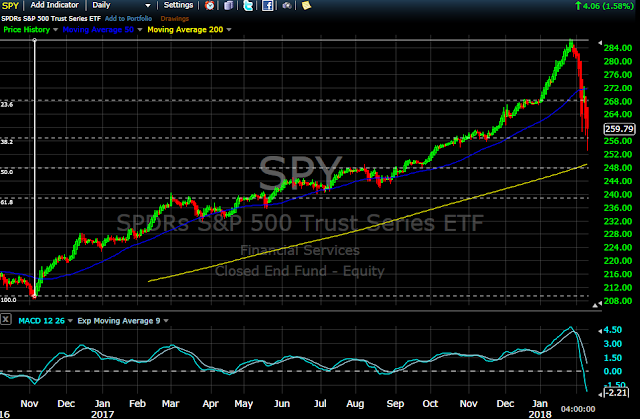Trump rally
- 8-Nov-16 close 2139
- 26-Jan-18 close 2872 Gain: 733 pts or 34.27% (15 months)
$SPY since the Election (15 months) with Fibonacci retracement. (Fri 9 Feb 2018)
Fibonacci retracement S&P 500
23.60% 2,699.01
38.20% 2,591.99
50% 2,505.50 (**)
61.80% 2,419.01
(**)The 50% retracement is not based on a Fibonacci number. Instead, this number stems from Dow Theory's assertion that the averages often retrace half their prior move.
Fri 9 Feb 2018: 200dma 2539; low 2532; close 2619
A major test for the market here as the S&P 500 flirts with its 200-day simple moving average (2539). Today's low was 2532.
A test of support at the 200-day simple moving average could open the door to another flood of sell orders... OR... it could open the door to a strong rebound effort.
The last test of the 200dma came in early November 2016. It held and it was off to the races after that following the presidential election.
SPY - 10 months
$SPX - 6 months
The equity market dropped sharply this week, with the S&P 500, the Dow Jones Industrial Average, and the Nasdaq Composite losing around 5.0% apiece in volatile trading. Sizable gains on Tuesday and Friday helped keep losses somewhat in check, but they couldn't keep the major indices positive for the year. The three averages are down between 0.4% and 2.1% year to date.
This week's selling was related to fears about rising interest rates, and the realization that stocks have gone too far, too fast, but it was a collective de-risking effort following the implosion of short volatility ETFs that acted as the expedient for broad-based and indiscriminate selling activity. The S&P 500 soared 7.5% in the first four weeks of 2018 on top of last year's 19.4% rally.
Technical, mechanical, and psychological forces all came together to knock back the market in an abrupt fashion.
The S&P 500 breached its 50-day simple moving average for the first time in five months. Weak-handed investors were consistently shaken out of "buy-the-dip" trades this week, sending stocks, and investor sentiment, even lower.
Meanwhile, the CBOE Volatility Index (VIX), often referred to as the "investor fear gauge," ended the week higher by 66.7% at 28.86.
All 11 S&P 500 sectors finished the week in the red, with losses ranging between 2.8% (utilities) and 8.5% (energy). In general, cyclical sectors--including the heavily-weighted financial sector (-5.8%)--underperformed their countercyclical peers.
The energy sector struggled as West Texas Intermediate crude futures dropped 9.5% to $59.23 per barrel--their lowest level since the end of December.
Overseas, equity markets in Asia and Europe finished the week solidly lower, following Wall Street's lead.
China's Shanghai Composite and Hong Kong's Hang Seng led the retreat in Asia, dropping 9.5% apiece, while Germany's DAX and France's CAC set the pace in Europe with losses of 5.3% apiece.
The market still anticipates that the next rate hike will occur at the March FOMC meeting as Fed officials minimized this week's sell off, continuing to emphasize a path of gradual rate increases. The CME FedWatch Tool places the chances of a March rate hike at 71.9%, virtually unchanged from last week's 76.1%.




No comments:
Post a Comment